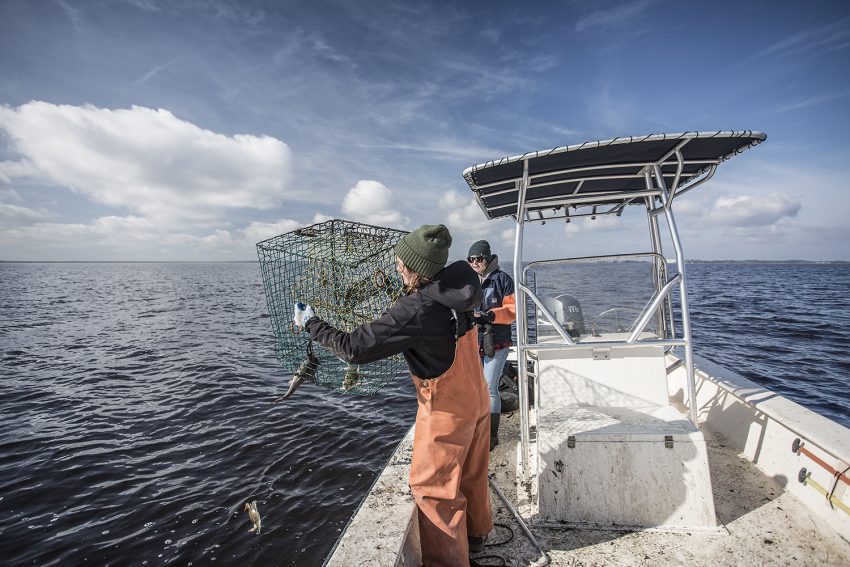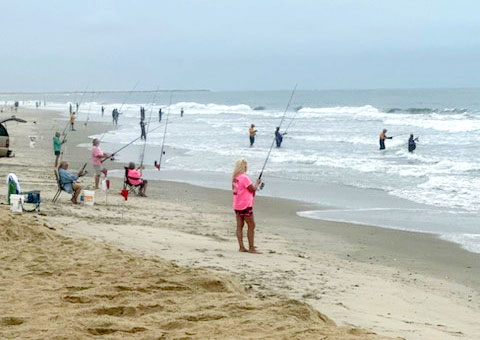55th annual Cape Hatteras Anglers Club tournament was ‘a logistical nightmare’
55th annual Cape Hatteras Anglers Club
tournament was ‘a logistical nightmare’
55th annual Cape Hatteras Anglers Club
tournament was ‘a logistical nightmare’
A long time ago, some guy that history remembers as “Murphy” came up with this law that most of us remember as going something like this: “Anything that can go wrong will go wrong.”
Last week, Nov. 7 -10, the 55th annual Cape Hatteras Anglers Club surf-fishing tournament—the largest tournament of its kind in the world—did its part to prove Mr. Murphy right.
“This whole thing has been a logistical nightmare,” said Larry Hardham, president of the Anglers Club. It was Friday afternoon. The final session of fishing had ended and the club was gearing up for that evening’s awards banquet.
Hardham chuckled a little as he admitted how tough this year’s tournament had been, no doubt relieved that the event was almost over and his sense of humor was mercifully still intact.
Of course, that was a few hours before an unanticipated power outage—which stretched from Tidewater Virginia to Hatteras village—unceremoniously interrupted the evening’s festivities.
Murphy.
In the end, 97 of the 120 teams that had signed up to participate braved the elements and overcame the obstacles to fish in this year’s tournament, landing a total of 153 fish over the course of two days.
But it certainly wasn’t easy—for anyone.
A few teams turned around and went home after waiting for more than eight hours in the ferry line on Wednesday afternoon and evening.
For those who did make it, the fishing didn’t turn out to be that great.
Because of the loss of usable beach, the stations, usually one-tenth-of-a-mile wide, were reduced to about 380 feet, with no stations at Ramp 55 in Hatteras, one of the most popular south-facing beaches.
In addition, several stations had to be moved because of ocean overwash and inaccessibility, and an entire session had to be canceled during Thursday afternoon’s high tide that had the ocean lapping at the base of the dunes. It was something that Hardham said had never happened in his 14 years as club president.
Things were tricky for the judges, too.
Only 25 of the confirmed 28 sets of judges were able to make it down this year, which made for a tricky situation. Normally, each judge has four teams per session, with the assignments being randomly generated by a computer program. But this year, because of the number of empty slots from teams and judges that couldn’t make it, some judges had six teams, while others had only two.
To top it off, a full-beach turtle nest closure between ramps 45 and 49 meant that it could take judges up to 30 minutes to travel between the stations on either side of the closure, since they would have to loop around it via the highway.
“It was an unusual situation all around,” Hardham said of the adjustments that had to be made this year. “I hope it never happens again.”
Obviously, the problems began a week or so before, when unholy Superstorm Sandy barreled past the Outer Banks on its way to the northeast.
Since the majority of the tournament’s teams and judges come from out of town—and since transportation to and from the island was uncertain—tournament directors had to decide whether this year’s event would take place at all.
On the Thursday following the storm, Hardham attended the public meeting that was held in Avon, where it was announced that the Stumpy Point ferry would be making upwards of 10 runs per day, with priority given only to vehicles carrying essential commodities and materials.
Working on that information, the club contacted all 120 teams that were eligible to fish in this year’s tournament and everyone who had committed to judging. They told them the situation and asked whether any of them would—or could, given that many of them hail from some of the hardest-hit areas of the East Coast—come out to fish if they went ahead with tournament.
According to director Sue Glass, they initially got positive confirmation from about 80 teams, and by the time everyone had responded to messages and e-mails, that number increased to about 93 teams and all but a handful of judges.
In light of that kind of participation, they decided to go ahead with the tournament.
It’s helpful to remember that this tournament is kind of a big deal.
It’s the largest surf-fishing tournament in the world, and it’s been going on for over 50 years. More than $20,000 in cash and prizes are at stake, and there are teams that have been waiting for over a decade trying to get in.
It’s kind of like the New York City Marathon of surf-fishing tournaments.
But that wasn’t the only factor that went into the club’s decision to host the tournament.
As Hardham explained, one of the main reasons this tournament was started was to bring visitors to the island, boosting its economy during the historically slow “shoulder” season.
Especially in the wake of Sandy, when many businesses could really use a late-season push, Hardham said the club “felt an obligation to honor that commitment.” They knew it would be a challenge, but they were prepared to make the best of it.
That was before news of a northeaster that followed on the heels of Sandy and before it was announced that Hatteras Island residents would have weekday priority on the ferry.
Hardham was quick to say that he thought the county was absolutely right in granting weekday priority to residents, and that he in no way begrudged their decision.
However, that didn’t change the fact that, with tournament registration on Wednesday, it made an already precarious travel situation all the more daunting for tournament participants.
The club alerted all teams of the new regulations and advised them to come early to avoid lines. They also asked them to consider using the Swan Quarter, Cedar Island, and Ocracoke ferry routes, and they left registration open all night on Wednesday to avoid cutting anyone who might be stuck in line out of the tournament.
Backlash, though, was imminent.
In the midst of all this came the news on Wednesday evening that, because of storm-related wind and tide, Ramp 27 was flooded, which meant that the 12 stations the club had set up there had to be moved.
Few things cause more stress in a surf-fishing tournament—for directors, anglers and judges—than having to move stations.
It meant that all the work Hardham and the other tournament directors had done the previous weekend—determining which beaches were usable, figuring out how they could organize the stations to ensure that each team had a morning and an afternoon session on both a south-facing and east-facing beach, and writing out directions so that teams and judges knew exactly where to fish and how to get there—had to be redone.
And then came what was perhaps the most contentious point of the whole tournament—the canceled session on Thursday afternoon.
Five stations had already been moved Thursday morning at Ramp 23, and by 11 a.m., rising tide was threatening the accessibility of the stations at Ramp 49, with high tide still four hours away.
The organizers were increasingly concerned that the teams fishing in those stations would be stranded, and that judges wouldn’t be able to get out there—or wouldn’t want to risk going out there. There wasn’t really any way to move those stations by the second session, and ultimately, nowhere to put them that would ensure fairness to all teams involved.
Canceling the second session was a tough decision for tournament directors—and one that was not well received by many of the anglers who lost their second chance to fish a south-facing beach, which is where the majority of the scoreable fish were caught this year.
“I understand how these people feel,” Hardham said, “and I regret that they are not happy. We hope they all come back.”
As back-up generators provided electricity to the clubhouse during Friday night’s random power outage, Hardham and the other tournament directors handed out the prizes to the winning teams.
And this year, to further efforts to boost local businesses and give winners, more choice in what they won, the prize packages included gift certificates to local stores and tackle shops worth several thousands of dollars.
Prizes were awarded for first-, second-, and third-place overall, as well as to the winners of each session. There were additional prizes for the men and women who caught the largest red drum, the largest bluefish, and the largest fish other than a red drum or bluefish.
First place went to team Blue Shoe from Greensboro, N.C., second place went to the Tri-Village Anglers from Ahoskie, N.C., and third place went to Kinnakeet’s Luring Ladies from Avon, N.C.
Singing the Blues, from Virginia Beach won the first session, with four fish and 33 points. Backlash from Maidens, Va., won the third session with two fish and 16 points, and Queen Mackeral from Nags Head won the fourth session with three fish and 19 points.
The prizes for largest red drum went to Meg Lesocky from the Reel Women team, who caught a 19 ¾-inch drum, and to Fred Jelinek from the Raleigh Saltwater Sportfishing team, for his 21 ¼-inch drum.
Summer Bracher, from The Stormy Gales, won the prize for largest bluefish caught by a female with her 11 ¼-inch bluefish.
The contest for largest bluefish caught by a male ended in a 5-way tie between L.T. Eure with the F-Team, Bill Gorham with Ridge Anglers, Justin Grizzard with Ridge Anglers, Bill Hall with SCABS, and Eddie Ochs with Sandfiddlers, all of whom caught an 11-inch bluefish.
The prizes for largest fish other than a red drum or bluefish went to Susan McClanahan of the Kinky Leaders for her 17-inch sea mullet, and to Larry Easterwood of Blue Shoe for his 20 ½-inch speckled trout.
Congratulations to all this year’s winners, and to everyone involved. May next year bring fairer weather and tighter lines.







